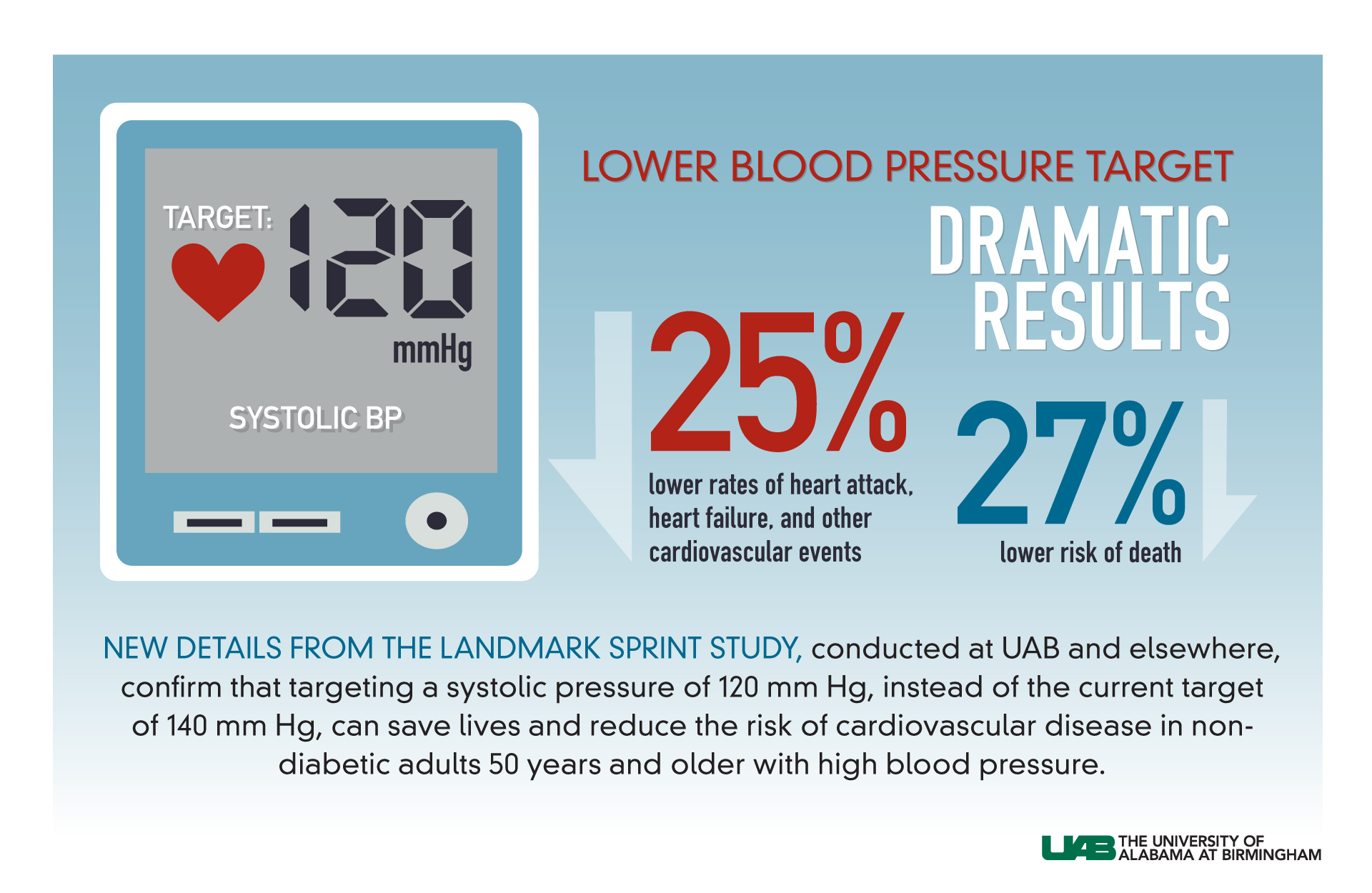 Suzanne Oparil, left, and Cora LewisFinal results from the landmark SPRINT study, published online today in the New England Journal of Medicine, confirm that treating adults 50 years and older with high blood pressure — but without diabetes or prior stroke — to a systolic blood pressure of 120 reduces the risk of cardiovascular disease and can save lives.
Suzanne Oparil, left, and Cora LewisFinal results from the landmark SPRINT study, published online today in the New England Journal of Medicine, confirm that treating adults 50 years and older with high blood pressure — but without diabetes or prior stroke — to a systolic blood pressure of 120 reduces the risk of cardiovascular disease and can save lives.
These results from the Systolic Blood Pressure Intervention Trial, or SPRINT, were presented today at the American Heart Association 2015 Scientific Sessions in Orlando. The results are in part products of the work by UAB investigators, including University of Alabama at Birmingham School of Medicine professors Suzanne Oparil, M.D., Cora E. Lewis, M.D., David Calhoun, M.D., Stephen Glasser, M.D., and Virginia Wadley Bradley, Ph.D. Their work was highlighted when preliminary findings were announced in September.
The study demonstrates that treating patients 50 and older with high blood pressure to a systolic blood pressure of less than 120 mm Hg reduced rates of cardiovascular events, including death due to cardiovascular disease, heart failure, stroke and heart attack, by 25 percent. Additionally, reducing systolic blood pressure to this target reduced the risk of death due to all causes by 27 percent compared to a target systolic blood pressure of 140 mm Hg.
“By design, SPRINT enrolled a diverse population of adults at sufficiently high risk for cardiovascular events and death to ensure adequate statistical power,” said Oparil, principal investigator for the UAB hub of the SPRINT trial, Distinguished Professor of Medicine, and director of the Vascular Biology and Hypertension Program in UAB’s School of Medicine. “Achieving the lower systolic blood pressure goal required use of additional medications — on average, an additional one or more — and extra clinic visits, so the findings represent more work for clinicians and patients. However, we strongly believe that it is worth it in terms of saving lives and reducing cardiovascular death events.”
“The results of SPRINT are likely to have a major impact on the treatment of hypertension,” added Lewis, co-principal investigator of the UAB hub and professor of preventive medicine. “However, there are many important lessons to be learned from SPRINT to apply the results in a safe and effective manner.”
In their report, investigators provided detailed data showing that both cardiovascular deaths and overall deaths were lower in the intensive treatment group. Certain types of serious consequences were more common in the intensive group, including low blood pressure, fainting, electrolyte abnormalities and acute kidney damage.
However, other serious adverse events associated with lower blood pressure, including slow heart rate and falls with injuries, were not increased in the intensive group. In patients with chronic kidney disease, there was no difference in the rate of serious decline in kidney function between the two blood pressure goal groups.
 “The benefits of more intensive blood pressure lowering exceeded the potential for harm, regardless of age, gender, or race or ethnicity,” Oparil said.
“The benefits of more intensive blood pressure lowering exceeded the potential for harm, regardless of age, gender, or race or ethnicity,” Oparil said.
The study continues to examine kidney disease, cognitive function and dementia among SPRINT participants; however, these results are not yet available as additional information will be collected and analyzed over the next year.
“Although the study provides strong evidence that a lower blood pressure target saves lives, patients and their health care providers may want to wait to see how guideline groups incorporate this study with other scientific reports into any future hypertension guidelines,” said study co-author Lawrence Fine, M.D., chief of the Clinical Applications and Prevention Branch at the National Heart, Lung and Blood Institute. “In the meantime, patients should talk to their health care providers to determine whether this lower goal is best for their individual care.”
Lewis says it is still important for those with high blood pressure to engage in a healthy diet, be physically active, maintain a healthy weight and learn to check their own blood pressure. All of these, Lewis says, will help to achieve blood pressure control.
“It’s important to remember that healthy lifestyle changes can make a difference in controlling high blood pressure, no matter the goal,” Lewis said.
UAB’s School of Medicine played major clinical and leadership roles in the SPRINT study. The study, which began in fall 2009, included more than 9,300 participants age 50 and older, recruited from about 100 medical centers and clinical practices throughout the United States and Puerto Rico. UAB was selected by the NIH as one of five hubs to recruit and direct almost 20 of these clinics from Massachusetts to Puerto Rico; UAB-directed clinics recruited more than 1,950 study participants, surpassing the study’s initial goal for UAB’s network.
About 36 percent of participants were women, 58 percent were white, 38 percent were African-American, and 11 percent were Hispanic. The SPRINT study did not include patients with diabetes, prior stroke or polycystic kidney disease, as other National Institutes of Health trials were studying those particular populations.
Approximately 28 percent of SPRINT participants were 75 or older, and 28 percent had chronic kidney disease. The study tested a strategy of using blood pressure medications to achieve the targeted goals of less than 120 mm Hg (intensive treatment group) versus the 140 mm Hg (standard treatment group).
“Although many classes of medications were available, emphasis was placed on using classes with the best outcomes in large clinical trials, including thiazide-type diuretics, calcium channel blockers, and angiotensin-converting enzyme inhibitors or angiotensin receptor blockers,” Oparil said. “Other agents could be added if necessary.”
The study’s blood pressure intervention, which was to finish in summer 2016, finished earlier after National Heart, Lung and Blood Institute Director Gary H. Gibbons, M.D., took action when the Data and Safety Monitoring Board interpreted the benefits of the lower goal as far outweighing the harms. The findings were announced in September, with the detailed results presented today.
“SPRINT is part of a proud legacy of NIH-funded clinical trials that will change clinical practice and save lives for decades to come,” Gibbons said. “These results reinforce the compelling public health importance of enhancing the awareness, treatment and control of hypertension in this country and around the world.”
In addition to primary sponsorship by the NHLBI, SPRINT is co-sponsored by the NIH’s National Institute of Diabetes and Digestive and Kidney Diseases, the National Institute of Neurological Disorders and Stroke, and the National Institute on Aging.
UAB role
Experts in blood pressure management, primary care physicians, nephrologists or other health care providers have seen SPRINT participants regularly for a period of four to six years. UAB’s Vascular Biology and Hypertension Research Program Clinic, part of the UAB School of MedicineDivision of Cardiovascular Disease and directed by professor of medicine David Calhoun, M.D., was one of several clinics that enrolled patients in Alabama. Athens Internal Medicine had the largest patient population in the study, with the more than 300 enrollees. The UAB Division of Nephrology and Nephrology Associates in Birmingham also participated and enrolled an important subgroup of patients with chronic kidney disease.
In addition to clinical roles, UAB faculty also have leadership roles in the SPRINT trial. Oparil and Lewis are on the trialwide steering committee and co-lead the morbidity and mortality committee, in which capacity Oparil, Lewis and their committee members review medical records in order to determine whether trial participants have had a heart attack, heart failure, stroke or other cardiovascular event. Lewis also leads the measurement procedures and quality control committee and serves on the executive committee for the study.
Virginia Wadley Bradley, M.D., professor of medicine in the Division of Gerontology, Geriatrics and Palliative Care, is co-lead of the trial’s MIND committee, which oversees the cognitive and dementia aspects of the trial. Tom Ramsey, a program manager in the Division of Preventive Medicine, is the lead author of the trial’s recruitment paper, which is currently under review. Steve Glasser, M.D., professor of medicine in Preventive Medicine is a cardiologist who also is on the trial’s morbidity and mortality committee.
“UAB was selected and is able to be a part of this remarkable study because we put together a great team of investigators and staff to run the hub,” said Lewis, the co-principal investigator of the UAB hub. “We recruited a good diversity of clinics that could bring in diverse patients and achieve the study recruitment goals, we wrote an outstanding application, and we have a lot of relevant experience for all aspects of the trial. We are able to provide all of the logistical support, and we have the infrastructure to handle a trial of this scope and magnitude. It was an incredibly competitive selection process.”